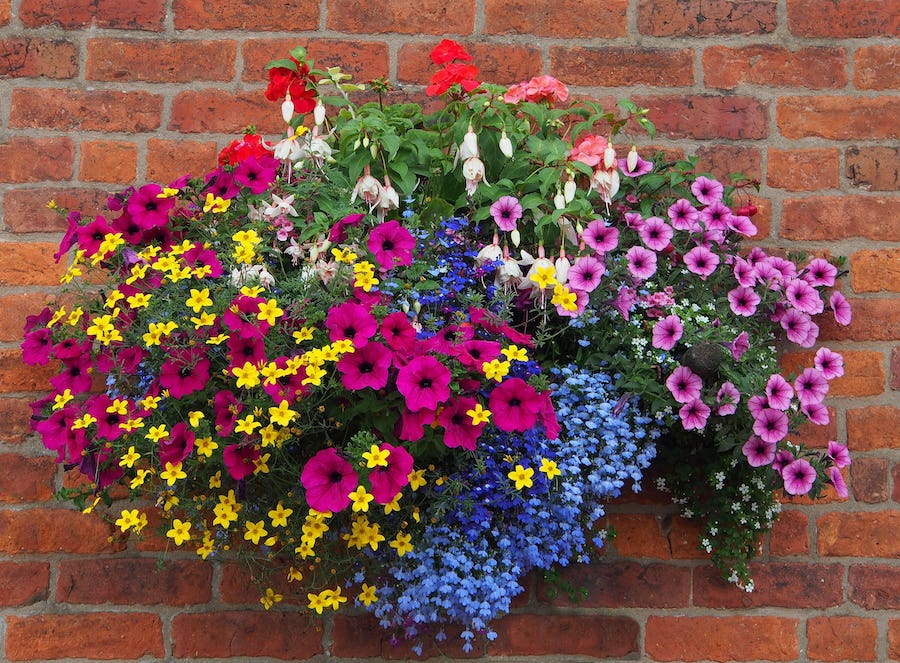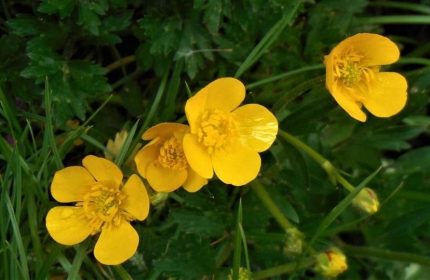How to make hanging baskets out of throwaway junk
Kitchen colanders, old wellies and woolly jumpers can help create beautiful hanging baskets, says gardening expert Chris Collins.
From milk cartons to baked beans tins, colanders to old pullovers, green fingered growers at Garden Organic are encouraging gardeners to get creative with their hanging baskets to help protect the planet and their purses.
With more of us taking up gardening during the pandemic, the horticultural charity is expecting a big uplift in the popularity of hanging baskets ahead of the summer. But if you don’t already have a regular basket to reuse, before visiting the garden centre check what you might have lying around at home that could be transformed into a sustainable container.
Former Blue Peter gardener and Garden Organic’s head of horticulture Chris Collins says: “I live in a flat with a balcony, so container growing and hanging baskets are an important part of my organic growing life.

Chris Collins on his balcony
“You don’t need to spend a lot of money; you can make your own highly-original ‘basket’, which can be a delight throughout the year. Many can be made from your household rubbish – much better for the environment and an excellent talking point as we spend time with friends and family outside again.”
4 common household items to upcycle into hanging baskets
1. Colander
View this post on Instagram
An old colander, with its ready-made drainage holes, is ideal. “Just make sure you line it with a layer of grit or matting (such as recycled jute, sisal or coir), moss or even an old woollen jumper – this must be 100% wool as synthetic fibres can break down into the soil – to prevent the compost blocking the holes or falling out,” Collins advises. “They will have a tendency to dry out quicker than other baskets, but are a perfect home for plants that don’t mind dry conditions, like succulents or thyme.”
2. Old wellington boots
View this post on Instagram
Old wellies make quirky additions to the patio and if you haven’t much ground space, you can simply hang them up on a post or wall and then fill them with compost and pretty trailing plants.
3. Tin cans
View this post on Instagram
These can be painted in bright colours or in subtle tones, depending on the effect you want, with drill holes in the base for drainage and the sides so you can suspend them with string from posts. Some people make feature walls and posts of different coloured cans, cascading with bright flowers.
“Bold new baskets can be filled with repeat flowerers like pelargoniums, petunia and begonia which will keep blooming through the summer,” says Collins.
4. Single-use plastics
View this post on Instagram
“Hanging baskets aren’t just for decoration. They’re also great for growing herbs and veggies,” says Collins. “My strawberries did well last year in their milk bottle tower and I’ve got tomatoes growing in DIY containers, too.
“Coriander, basil and parsley leaves will make delicious additions to your dinner. Chives and thyme will also give delightful flowers which pollinators will love as much as you.
“Tumbling tomatoes and chilli peppers will all flower and fruit so long as they are in a sheltered, sunny position. By growing your own in this way, you’re helping to reduce your food miles and cut down on single-use plastic packaging.”
How to achieve hanging basket success

Get the right soil mix: “All plants grown in containers need plenty of nutrients, especially flowering ones. Get your potting mix right by using peat free potting compost or making your own,” says Collins.
“A combination of soil with homemade compost and grit to give good drainage will make an ideal growing mix. Top up with a liquid feed every couple of weeks. Make your own from comfrey or nettle leaves steeped in water or buy a certified organic fertiliser.”
View this post on Instagram
Deadhead often: “Keep deadheading regularly. This prevents the plant from setting seed, and encourages further blooms.”
Site your basket sensibly: “Choose your hanging place wisely. You need plenty of sun and shelter from wind.”
Further information and tips on growing organically can be found at gardenorganic.org.uk.
The Press Association
Latest posts by The Press Association (see all)
- Princess Charlotte set to celebrate ninth birthday - May 1, 2024
- How edible flowers can make your dishes look and taste divine - April 30, 2024
- Beauty entrepreneur Liz Earle on turning 60: Ageing is a gift - April 30, 2024
- Unseen photo of William and Kate’s wedding released to mark 13 years of marriage - April 29, 2024
- The Tattooist Of Auschwitz author Heather Morris on why now is the perfect time for a TV adaptation - April 29, 2024




















